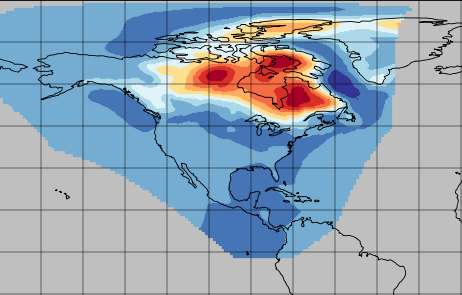Solid-Earth
Progress (February 2019)
The assumption of a fixed ocean bottom is increasingly unrealistic given the known recent acceleration in ocean mass and resultant elastic response (deformation) of the ocean floor. We have therefore revised the sea level budget (SLB) with a data-driven mass-volume model that allows the ocean bottom to deform through inclusion of an additional OBD term. We have also investigated whether global observations of sea surface height, ocean mass and steric changes allow us to obtain a data driven estimate of OBD. This work is currently being written up for submission.
Progress (November 2018)
A new area of investigation for us has been to develop the BHM framework to explore vertical land motion (VLM) for North America, with the aim of separating the signal into its GIA and mass change components. This will be the first time that we have assimilated GRACE and GPS data simultaneously, which should allow us to ‘solve for’ (i.e. create BHM-predictions of) GIA and mass change. North America has been selected as it is well observed, the geophysical processes are relatively well understood and we are able to build on and test previous work by Simon et al (2017).
Early results from this work are encouraging, and our BHM-predicted GIA trend (see figure below) shows a similar magnitude and pattern to that reported by Simon et al. Future work is planned to further improve the GPS data, as well as investigate whether the elastic response to mass changes is an important signal that we should also be including.

BHM-predicted GIA trend for 2005-2015 for North America
Progress (April 2018)
The main achievement so far has been the creation of a global GPS dataset that provides a ‘clean’ signal of glacial isostatic adjustment (GIA) and is, therefore, suitable to investigate the behaviour of global GIA forward models. We have developed a fully-automatic strategy to post-process GPS time series and to correct for non-GIA artefacts. The output is a dataset of ~4000 GPS vertical velocities as an observational estimate of global GIA uplift rates. The dataset will subsequently be used to improve existing global forward model solutions within our BHM framework through identification of statistically significant deviations between the observations and the models.
Next page: Outputs
